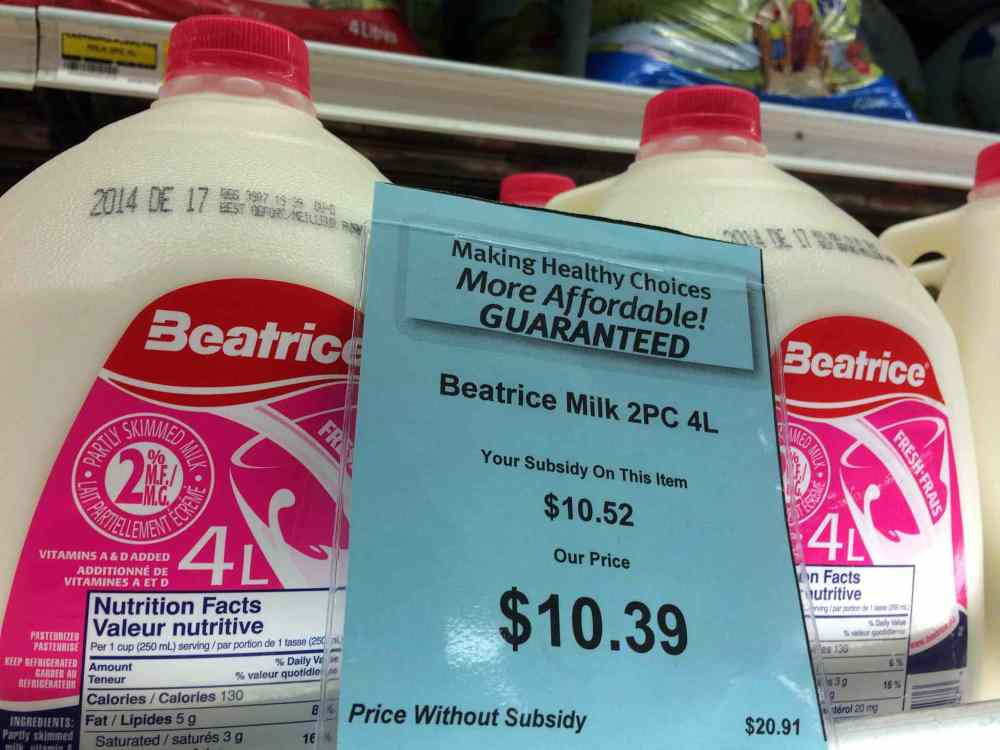Food security off the table in election
Advertisement
Read this article for free:
or
Already have an account? Log in here »
To continue reading, please subscribe:
Monthly Digital Subscription
$0 for the first 4 weeks*
- Enjoy unlimited reading on winnipegfreepress.com
- Read the E-Edition, our digital replica newspaper
- Access News Break, our award-winning app
- Play interactive puzzles
*No charge for 4 weeks then price increases to the regular rate of $19.00 plus GST every four weeks. Offer available to new and qualified returning subscribers only. Cancel any time.
Monthly Digital Subscription
$4.75/week*
- Enjoy unlimited reading on winnipegfreepress.com
- Read the E-Edition, our digital replica newspaper
- Access News Break, our award-winning app
- Play interactive puzzles
*Billed as $19 plus GST every four weeks. Cancel any time.
To continue reading, please subscribe:
Add Free Press access to your Brandon Sun subscription for only an additional
$1 for the first 4 weeks*
*Your next subscription payment will increase by $1.00 and you will be charged $16.99 plus GST for four weeks. After four weeks, your payment will increase to $23.99 plus GST every four weeks.
Read unlimited articles for free today:
or
Already have an account? Log in here »
Hey there, time traveller!
This article was published 24/09/2015 (3725 days ago), so information in it may no longer be current.
‘Finish your dinner! Somewhere in the world a hungry child would love to have yours!’
This age-old reminder of inequality has lost none of its poignancy. How likely are you to think about food insecurity tonight at the dinner table? How likely are you to remember “somewhere in the world” is right here in your own country?
Food insecurity — the lack of nutritious, culturally appropriate food — is a persistent reality across Canada. In 2011, one in eight households experienced some level of food insecurity. That means 1.1 million children were affected. For indigenous peoples living in the North, the situation is more extreme. For instance, 70 per cent of adults and 62 per cent of children in Nunavut, as well as 60 per cent of on-reserve households in northern Manitoba, are food-insecure. According to the United Nations Special Rapporteur on the Right to Food, these rates of food insecurity are six times the national average and “represent the highest documented food-insecurity rate for any aboriginal population in a developed country.”

Food insecurity is a serious threat to indigenous peoples’ health in Canada, and particularly in the North. Mothers in northern communities must resort to feeding their children powdered “juice” or condensed milk rather than formula, and “tummy-fillers” such as pasta and rice just to get by. When children don’t get enough good-quality, nutritious food, their ability to learn, remember and manage emotions is affected. Poor diet can lead to anemia, cavities, lowered immunity, obesity and higher rates of chronic diseases such as heart disease, diabetes, and even rickets. (A recent study found northern indigenous children were six to 12 times more likely than other children to develop rickets.)
The causes of northern food insecurity are complex. It results from a combination of poverty, geography (many communities are accessible only by plane or briefly by winter roads and summer sealift), colonialism and lack of access to traditional land-based food, combined with ill-conceived government programs and corporate practices. The legacy of the residential school system continues to play a big role, having broken the cycle of learning about how to hunt and gather food.
The current government approach to address food insecurity in Northern Canada is a food-subsidy program called Nutrition North Canada. Nutrition North is paid directly to retailers, and the store is expected to pass on those savings to the consumer at the point of sale. However, with zero oversight, there are serious doubts consumers actually benefit from Nutrition North, said the 2014 auditor general’s report. This situation is exacerbated by the fact there is almost no retail competition. The North West Company receives almost 60 per cent of the total Nutrition North subsidy and also enjoys a virtual monopoly on the sale of food in the Canadian North. It’s no wonder the cost of food in northern communities remains prohibitively high.
In 2011, the average cost of feeding a family of four for one week (according to the revised northern food basket — a standardized government measure) was $546 — a record high. To make matters worse, Nutrition North does not subsidize items necessary to pursue hunting and fishing activities such as fishing nets, boat motor parts, ammunition and gas, nor does it support the purchase of diapers, toilet paper, hygiene products or medical devices. Some of the most highly subsidized foods are not traditionally eaten by indigenous peoples, imposing food choices on northerners that are not their own.
In 2014, the auditor general released a report that criticized the effectiveness of Nutrition North and called upon the federal government to address food insecurity in Northern Canada. The report identified many areas of concern, including the fact many northern communities are ineligible for the Nutrition North subsidy. In northern Ontario, only eight of 32 fly-in communities are eligible for the full subsidy, leaving many on their own when it comes to a hefty grocery bill.
In response to the auditor general’s report, the Harper government promised to address the program’s deficits. However, when an MP for the Northwest Territories proposed a motion in March that called for reforms to Nutrition North that included the “addition of 46 remote communities currently ineligible for the program,” it was defeated in the House of Commons.
It is high time for the federal government to start listening to northerners and indigenous peoples in Canada who know best what they need to achieve food security. Providing sustainable funding for community food co-ordinators in all northern communities is a first step toward inclusive and community-based solutions. There also needs to be a complete overhaul of Nutrition North that includes financial support for hunting and gathering and own-food production, as well as federal regulation of the prices for food and other necessary goods and services. A basic income floor adjusted to reflect northern costs would go a long way to alleviating poverty more broadly.
These are essential ways to support northern and indigenous peoples in achieving sustainable food security by empowering and co-operating with them. It’s the first step toward a Canada where no child has to sit at the table hungry. Let’s start on that path today.
Norma Kassi is with the Arctic Institute of Community Based Research and Amanda Sheedy is with Food Secure Canada.
History
Updated on Thursday, September 24, 2015 7:46 AM CDT: Replaces photo















